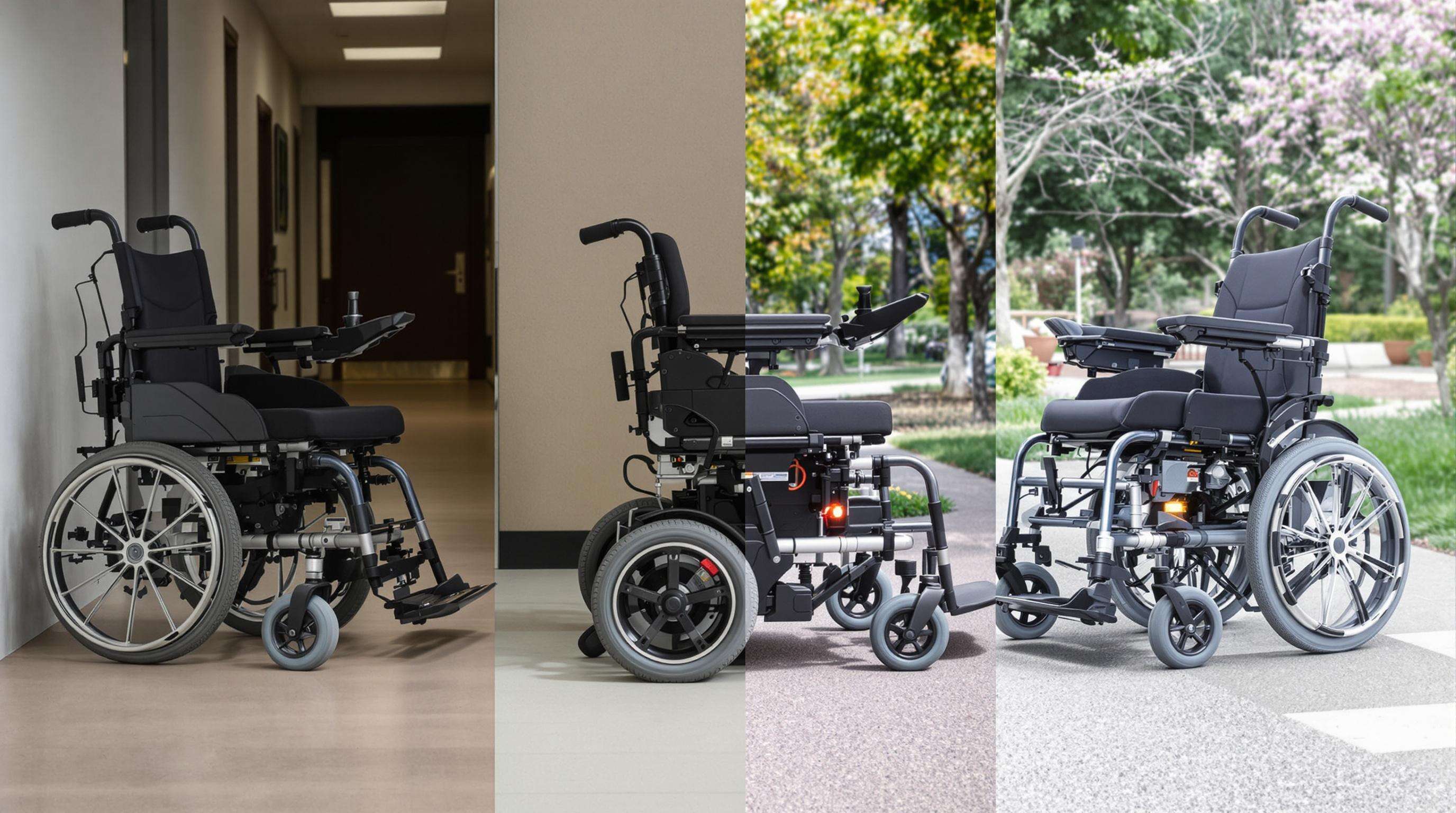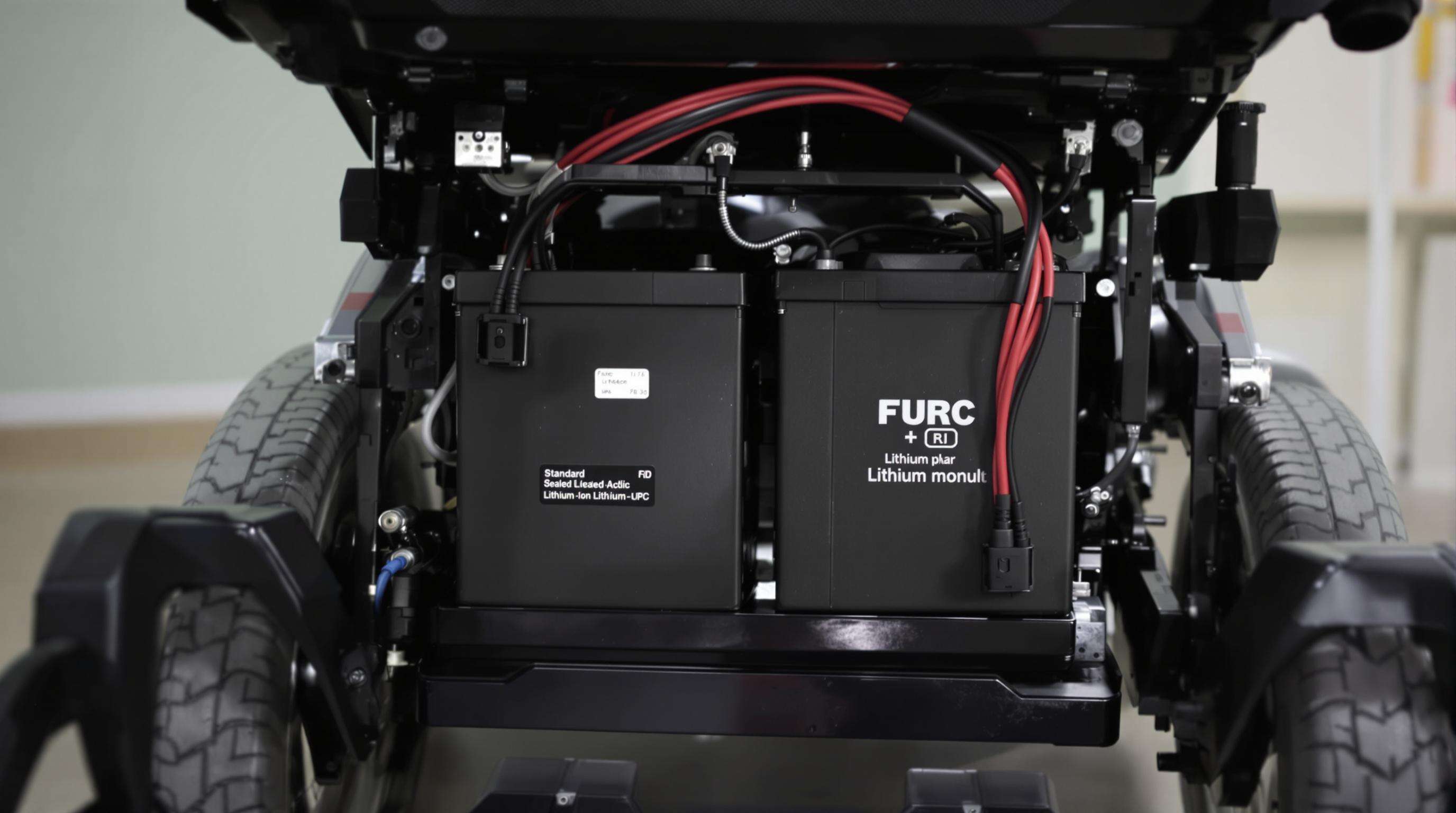When it comes to power wheelchairs, they generally fall into different categories based on where they're meant to be used. The indoor versions tend to be smaller overall and can turn in tighter spaces, usually around 25 inches or so for what's called Group 3 models. These work well in places with narrow corridors and door frames. Outdoor wheelchairs such as the Group 4 all terrain types have much sturdier builds, bigger wheels, and special suspension features that let them tackle hills at about 12 degree angles plus rough ground conditions. There are also hybrid options in Group 3 territory that try to do decently in both situations though they typically end up being heavier and not quite as good with battery life compared to specialized models.
These days, portable power wheelchairs can be surprisingly light, sometimes weighing just around 45 pounds. They come with foldable frames too, which means they take up only about 15% of the space when folded compared to when they're being used. The reason for such lightweight yet sturdy designs? Better materials like improved aluminum alloys combined with lithium batteries that pack serious punch without adding extra weight. Most models today can actually handle weights up to 300 pounds and still meet those strict airline transportation standards. Take one company's upcoming 2025 model for instance it manages an impressive 40 mile range all while staying under 55 pounds thanks largely to optimized brushless motors technology that makes everything run smoother and last longer between charges.
Power wheelchairs that perform well have these cool modular features that let them handle all sorts of different places. Think about it - people can flip between an indoor "precision mode" where they slow things down around 30% so they can maneuver through tight spaces without crashing into stuff. Then there's the outdoor "traction mode" which gives them about 50% more power when going over curbs or bumpy pavement. Pretty neat right? According to some research done last year, most folks actually use at least two of these settings every single day. Makes sense since we spend time both inside buildings and out in the real world where conditions change constantly.
When selecting a power wheelchair, consider:

The power of the motor makes all the difference when it comes to climbing hills and moving over rough terrain. Most wheelchairs come with high torque motors ranging from around 250 to 400 watts, which allows them to reach speeds of about six miles per hour. But there's always a trade off here because stronger motors drain batteries faster. Lithium ion batteries generally last between ten and twenty miles on a full charge if everything goes perfectly. Realistically though, people tend to get about thirty percent less range when going up steep hills, based on what we've seen in various drive system tests. For those buying these devices in bulk, looking at motors that can adjust their power output dynamically becomes really important. These smart motors save energy whether someone weighs ninety pounds or three hundred fifty pounds, and regardless of how frequently they use the chair during different parts of the day.
Drive configuration significantly affects handling and stability:
| Drive Type | Turning Radius | Best For | Drawbacks |
|---|---|---|---|
| Front-Wheel | 40"–48" | Outdoor stability | Less precise indoors |
| Mid-Wheel | 28"–34" | Tight indoor spaces | Reduced outdoor traction |
| Rear-Wheel | 36"–42" | Balanced performance | Higher maintenance needs |
Mid-wheel drives dominate institutional settings where 85% of use occurs indoors, while rear-wheel systems are favored in mixed urban environments.
For wheelchair users navigating indoors, getting through standard ADA compliant doorways requires a turning radius of around 34 inches or smaller. Most facility managers actually put this requirement at number one when buying new equipment according to recent surveys showing about seven out of ten prioritize it above all else. When we look at outdoor models though, manufacturers have had to compromise on those tight turns, typically offering radii between 42 and 50 inches instead. The trade off here is better stability on slopes that can reach up to 12 degrees. Fortunately, newer hybrid suspension technology is starting to bridge this divide. Some models now transition from inside to outside spaces roughly 20 percent quicker than their predecessors, which makes a real difference for people who move between different environments throughout their day.
Modern controllers balance hill-climbing torque with energy conservation, maintaining 18–22 miles of daily range. Regenerative braking recovers 8–12% of energy during descents, while variable resistance programming adjusts output based on user weight. These innovations reduce average wholesale replacement costs by $230 per unit annually compared to older systems.

Power wheelchairs now mostly rely on lithium-ion (Li-ion) batteries these days, which tend to last around 5 to 7 years compared to just 2 or 3 years for traditional sealed lead-acid (SLA) options. The initial price tag is definitely higher for Li-ion systems though, costing somewhere between $200 and $350 per kilowatt hour versus about $120 to $200 for SLA batteries. But when looking at the big picture, many wheelchair users find that the extra money pays off over time because they don't need to replace the battery as often. Plus, charging takes only 1 to 3 hours instead of the full 8 to 10 hours required by older models. And let's not forget there's almost no maintenance needed with Li-ion technology. Recent research from the 2025 Battery Technology Comparison Study backs up these observations, highlighting several important distinctions between the different battery types available today.
| Battery Type | Avg. Lifespan | Charging Time | Cost/kWh | Charge Cycles |
|---|---|---|---|---|
| Lithium-Ion | 5–7 years | 1–3 hours | $200–350 | 2,000–4,000 |
| Sealed Lead-Acid | 2–3 years | 8–10 hours | $120–200 | 500–800 |
Most modern Li-ion power wheelchair batteries offer 12–18 miles per charge, with some supporting USB-C fast charging. Performance can drop 15–20% in extreme temperatures, a critical factor for outdoor users.
Over seven years, Li-ion systems cost 40% less than SLA despite higher initial investment. Key savings come from:
Manufacturers are integrating solid-state batteries with 20% higher energy density and AI-driven charging systems that learn user patterns. These technologies aim for 8–10 year lifespans while adhering to ISO 7176 safety standards for medical mobility devices.
Getting seats customized properly really matters if we want to avoid pressure sores and keep good posture while sitting for long periods. Most standard seats come with widths between around 16 inches and 20 inches, plus they usually allow depth changes of about two inches either way to accommodate different body shapes. For those who spend hours in one position, backrests that can be adjusted from roughly 10 degrees up to 30 degrees recline work wonders. Some models even feature tilt-in-space mechanisms going all the way to 45 degrees, which helps spread out the pressure points across the body. According to recent research published by the American Academy of Physical Medicine and Rehabilitation last year, special cushions filled with gel or containing air cells cut down on shear forces by nearly a quarter when compared to regular foam cushions. That makes a real difference over time.
Weight capacities range from 250 lbs in standard models to over 600 lbs in bariatric versions. Adjustable armrests and swing-away footrests are recommended for 87% of users requiring lateral transfers. Modular frames allow quick addition of abductor pads or lumbar supports using tool-free systems, typically completed within 15 minutes.
Studies indicate that people who spend over eight hours a day sitting in wheelchairs can cut their risk of pressure sores by around 40% when they use models with proper ergonomic design and contoured seats. The best designs incorporate things like waterfall front edges which tilt at about thirty degrees to take pressure off the thighs, plus backrests that automatically shift position roughly every ninety minutes. These adjustments are really crucial for folks with restricted movement or those who don't feel sensations properly across their body.
The best performing models typically feature either reinforced steel or aircraft quality aluminum frames. The welded joints on these frames are put through rigorous testing and can handle static weights well beyond 500 pounds. When it comes to rough ground conditions, manufacturers build them with axles around 8 to 10 millimeters thick and equip them with four ply tires. This setup makes a noticeable difference in how they absorb shocks compared to regular models, probably somewhere between thirty to forty percent better. For places where moisture is a constant problem, applying corrosion resistant coatings really pays off. Equipment treated this way tends to last anywhere from four up to six extra years before needing replacement.
Most wholesale buyers (92%) prioritize suppliers compliant with ISO 13485 (medical device quality management) and MDR 2017/745 (EU medical device regulation). Essential certifications include:
| Certification | Scope | Testing Frequency |
|---|---|---|
| ANSI/RESNA WC-4 | Structural integrity | Annual load testing |
| IPX4 | Water resistance | Batch sample testing |
| UL 3300 | Electrical safety | Factory audit every 24 months |
Top manufacturers typically demonstrate:
A 5-phase evaluation framework ensures comprehensive supplier assessment:
| Phase | Focus Area | Key Metrics |
|---|---|---|
| 1 | Technical Capability | CNC machining precision (±0.05mm tolerance) |
| 2 | Quality Systems | CAPA resolution time (<72 hours) |
| 3 | Supply Chain Resilience | Availability of alternate component sources |
| 4 | Compliance History | Zero FDA warning letters in past 5 years |
| 5 | Total Cost Analysis | Battery replacement costs over 7-year lifecycle |
Entry-level wheelchairs may cost 35–45% less than premium models, but repair rates increase by 60% after 18 months of daily use. Independent testing reveals:
Choosing mid-tier suppliers with verified ISO certification typically lowers 5-year ownership costs by 18–22% compared to budget alternatives.
Some key considerations include the intended use environment (indoor vs. outdoor), transport frequency, home layout, surface types, and user comfort features like seating adjustability.
Lithium-ion batteries generally have longer lifespans (5-7 years) compared to sealed lead-acid batteries (2-3 years). They also charge quicker, require less maintenance, and have higher initial costs, which can be offset by reduced total operating costs over time.
Modular features allow wheelchairs to adapt to different environments and user needs, offering settings for indoor precision and outdoor traction, enhancing flexibility and performance in various scenarios.
The choice depends on your primary usage environment: mid-wheel drive is optimal for tight indoor spaces, front-wheel drive offers outdoor stability, while rear-wheel drive provides balanced performance but may require higher maintenance.
 Hot News
Hot News2025-05-15
2025-05-15
2025-05-15
2025-05-15
 ONLINE
ONLINE ONLINE
ONLINE
Copyright © 2025Ningbo Ks Medical Tech Co., Ltd. all rights reserved - Privacy policy